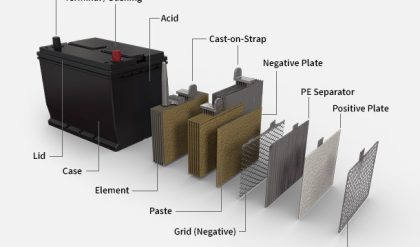Principle of electronic amplifiers
Amplification means making things bigger. In the context of electronics, it is the process of increasing the amplitude of signals. The functional block that accomplishes the task of signal amplification is called amplifier. Here, the term amplifier usually describes an electronic amplifier, in which the input signal is usually a voltage or a current.
There are both passive and active amplifiers. Example for passive amplifier is a step-up transformer. If an alternating voltage signal is applied at the input, a larger voltage signal will be available at the output. The power delivered to a load will be always less than the power absorbed at the input. Thus a transformer may provide voltage amplification but it cannot provide power amplification. Even though several passive amplifiers exist there, the most important and useful electronic amplifiers are active amplifiers.
A widely used symbol for an amplifier is shown in figure 12.1. Here Vi is the input voltage, Vo is the output voltage and Av represents voltage gain which is the ratio of the output voltage to input voltage.
The active amplifiers take power from an external energy source and use it to boost the input signal. Thus it delivers an output signal whose waveform corresponds to the input signal but its power level is higher.

The additional power content in the output signal is supplied by the DC (Direct Current) power source used to bias the active device. A block schematic for an active amplifier is given in figure 12.2.

The output waveform of an amplifier must be an exact replica of the input waveform. It preserves the details of the signal waveform and any deviation of the output waveform from the shape of the input waveform is considered as distortion.
Characteristics of an amplifier
Following are the important desirable characteristics of an amplifier

Feedback systems
A feedback system is one in which a part or fraction of the output is combined with the input. Feedback systems use the output information to modify the input signal to achieve the desired result.
Feedback systems are of two types (a). Negative feedback systems (b). Positive feedback systems.
In the negative feedback systems, feedback tends to reduce the input. This kind of feedback is called degenerative feedback. Negative feedback reduces the amplifier gain but it has many advantages such as gain stability, reduction in distortion and noise, increase in bandwidth, increase in input impedance and decrease in output impedance etc.
In the positive feedback systems, the feedback tends to increase the input. This form of feedback is called regenerative feedback. Since positive feedback causes excessive distortion and instability, it is seldom used in amplifiers. However, it increases the strength of the original signal and hence it is employed in oscillator circuits.
A feedback amplifier essentially consists of two parts, an amplifier and a feedback network as shown in Figure 12.21. The function of feedback network is to return a fraction of the output energy (voltage or current) to the input of the amplifier.
Feedback in amplifiers








